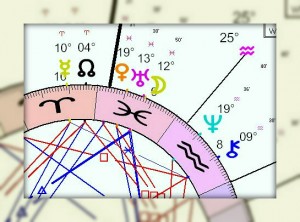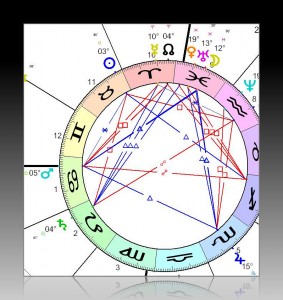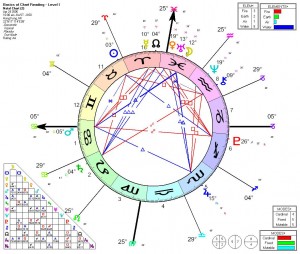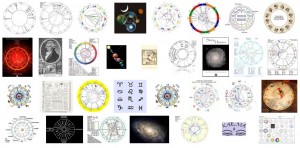Love Thy Neighbour
We talked about aspects in the past few posts. One more thing on that.
You may wonder how do we know whether 2 (or more) planets are “in aspect” (or “aspecting each other”). What is the criteria to determine that they can communicate with each other? Is it because of their nature? Is it for some other reasons, based on time, or space?
The truth is, this is an issue that has divided astrologers since… forever! So, I’ll tell you the theory, and you will have to experiment for yourself (after you have taken the course! 🙂 clever hint!) to see what works for you.
OK, so here it is: you probably have not noticed yet on the charts I showed you on the previous posts, but next to the planets, you can see a small figure next to the glyph. It is the ‘degree’. In the example below, you can see a yellow colour crescent (it is… the Moon. Dah!) and next to it ’12°’. It means that the Moon is at 12 degrees of Pisces (the sign next to the figure 12).
So once you know the degree of a planet, you can look for planets that are on the same degree (either of the same or different signs) to establish the aspects. For example, a planet that is at 12 Pisces and a planet that is at 12 Gemini will be in ‘exact aspect’.
It is very rare that 2 planets will be on EXACTLY the same degree, so you will need to allow for some variation on both sides of the degree when you consider that 2 planets aspect each other. The variation you allow is called an “orb”.
In the example above, you see that Moon at 12 Pisces and Mars at 5 Cancer (the turquoise colour glyph on the left hand side) at considered in aspect (there is a blue line connecting them) even though they are 7 degrees apart. The Sun (the dark blue circle with a dot in the middle) is at 3 Taurus and it is also in aspect to Mars, they are only 2 degrees apart.
The closer the orb, the more potent the aspect. So 2 planets which are on the same degree (although possibly in different signs) will have a strong connection.
You may be wondering: Up to which orb are 2 planets still in aspect? Whats is the rule of thumb for me to know that, ye, those 2 planets ARE in fact talking to each other and influencing each other?
Ah! Tough question. This is where astrologers have different views. Some people will consider that an acceptable orb is 5 degrees on both sides (so in the case of 12 Pisces, they will consider any degree between 7 and 17, i.e. 12-5 and 12+5 are valid aspects). Some will allow for a larger orb (usually up to 10 degrees on both sides), but some will have a stricter view. It depends.
Valid orbs also differ depending on what branch of astrology you practice, for example Mundane astrology, the astrology used to determine world affairs and events, or Horary astrology, which casts charts to answer questions, tend to use very narrow orbs. Progressed charts use only exact aspects. But this is out of our subject.
Want to know more and understand what’s behind all this? Sign up on the Astro Coach Academy Members List to get more in depth insights into how to interpret a chart and get members-only benefits when the eCourse comes online.
You’re Not The Boss Of Me
Have you ever had the experience of meeting someone and communication just flows? You understand each other without efforts? The conversation brings you new insights, you feel supported, encouraged and, in turn, you support and encourage. Your ideas are valued and recognised.
And have you ever had the exact opposite experience? No matter what you say or do, no matter how much efforts you make, you seem to be misunderstood, misread, belittled, denigrated, underestimated or even controlled, and very frustrated.
Remember the theatre play: some characters have a natural empathy for each other, they inherently understand and support each other. And some characters just don’t. It’s the same for planets.
How do you know whether 2 planets have smooth or challenging connection? Look at the aspects (the lines connecting the planets inside the inner circle).
By the way, notice that we talk about “smooth” or “challenging” communication, not “good or bad”. Nothing in an astro chart is good or bad per se. Sometimes challenging communication leads to the deepest insights and achievements. So try to use a descriptive language rather than judge.
Most astro charts will have some kind of ways to differentiate. In the example above (and many softwares will use this convention), blue means smooth and red means challenging.
How do you determine whether the line is red or blue? It has to do with the elements of the signs the planets are in. Some elements just have an innate friendliness, some don’t.
Want to know more? Join the Astro Coach Academy Member’s List. We’ll send you mini tutorials and you will get special benefits when the eCourse comes live.
Communication Is Key
Following up on the post “Introduction to the astro chart”, there is one more thing you want to know about planets. They communicate with each other.
Let’s have a look at the astro chart again.
You see the planets around the zodiac (represented by the circle). Then, you can see lines running within the inner limits of the circle from one planet to the other. Those are called ‘Aspects’ between planets, and essentially, it tells you:
1. that 2 (or more) planets are having a conversation,
2. and whether the conversation is flowing smoothly or not.
Why is it important to understand?
Well, just think about real people for a moment. Say you are faced with a dilemma or a problem, you have been thinking about it all by yourself for a moment, but you do not seem to see an answer. If you have no access to anyone, you’ll need to keep thinking about it all by yourself, maybe sleep over it and see whether an insight comes up the next morning. If you have a phone, you can call an expert you know will be able to assist you, or talk to a friend who may be able to give some insight because they know you well. If you have online access, you can connect and get a much wider range of information.
It is the same for the planets.
To go back to the theatre play analogy we used in a previous post, the actors either appear on-stage alone, or pairs, or in larger groups. Each actor has his or her own character, they behave in certain ways, but their behaviour may vary depending on who they interact with. Their environment will highlight different sides of their personality. Say a King will probably not behave the same way at a dinner party and on the battlefield.
The relationship between planets, as indicated by the aspects, will therefore give many insights as to how the planets interact with each other, what sides of their ‘personalities’ come out more readily and the general environment they live in.
More on aspects coming next.
Sign up on the Astro Coach Academy Members List to get more in depth insights into how to interpret a chart and get members-only benefits when the eCourse comes online.
Introduction to the Astro Chart
This is a quick introduction to the Astro Chart. We will go more in depth into this in another post down the road.
Basically, there are 3 concepts you want to understand:
– Planets
– Signs
– Houses
This is what an astro chart looks like:
Everything is there. By the way, this is a chart that was drawn for the beginning of an astro course I gave in 2007. Some people like to draw charts, not for the birth of a person, but to find the best time for events (say the day & time to sign a contract, buy a house etc…) In this particular case, I just drew this chart as a support for the particular course without looking for meaning and significance, but just to show our students what a chart can look like.
Let’s start with the planets. Can you see the funny looking larger signs in different colours? Those are the planets. when you study astrology, you will have to familiarise yourself with what we call “glyphs” (the funny-looking colourful symbols around the outer circle). They represent each planet. It is easier and faster to write the glyphs rather than the full name of the planet, plus the glyphs themselves have a symbolic significance. For example, the dark blue round shape with a dot inside is the Sun.
The smaller symbols that are next to the glyphs are the signs: Aries, Taurus, Gemini etc… Here the Sun is in Virgo (Virgo’s symbol is the turquoise colour symbol that looks like a stylised M with an ear on the right hand side).
And finally, the straight lines that come out of the circle and the numbers 1,2,3,4 etc… are the Houses.
So we say that each planet is in a certain sign and in a certain house. In the example above, the Sun is in Virgo in the 11th House.
What does this all mean? To make things simple, imagine a theatre play. The actors (planets) represent certain characters (example: a King) who may be wearing clothes (signs) that fit their status or not (the King may be dressed as a King or disguised as a beggar), and they appear in a certain setting (houses): the garden, inside the castle, on the battle field etc… The planets, signs and houses are the 3 fundamental pillars of the play of our lives.
We will learn how to give meaning to the chart during the course, so if you have not done so yet, join the Astro Coach academy members list here. You do not commit to sign up, you just tell us that you want to know more, and you will get a chance to benefit from the bonuses that our members will get when the course goes online.
Different Charts Styles
There are many different types of astro charts. Astrologers have been casting charts for different purposes and in different syles.
A quick survey of google images shows a wide variety of styles.
I use what is called the ‘French’ style.
You will find the style that suits you. I find that once you are used to a certain style, meaning easily comes to you when you look at the chart.
There are loads of charting and/or astrology softwares, some more professional than others. You can also go online, some websites will draw charts for you at no cost.
Any question or comment? Post them in the box below.
Musings
Astrology is an ancient art that has been practiced for thousands of years. The real significance of a chart draws into deep esoteric roots and have to do with the essence of the relationship between Humans and the universe.
I want to say this right now: at its core, Astrology is not about prediction (although it’s been widely used that way), it is about movement, flux and relationships. Astrology is not about the tangible, it is about the quantum, the intangible. Because of the secret nature of ancient astrology, what is left to us nowadays is often only surface meaning.
We, as humans, lean toward certainty. We want to know what is going to happen, we want to know that our world is going to behave a certain way. This explains why lots of time, we use the tools that astrology provides to tell the future. However, this is not what we will talk about on this website, and this is not what we will teach in the Astro Coach Academy course (by the way, if you have not signed up yet to the mailing list, do so now by clicking this link).
What we will talk about is how to practice the art of astrology to catalyse and unlock potentials. There is a difference between telling people what is going to happen to them (remind to tell you a story about self-fulfilling prophecies) and assist them to unlock their own potentials from inside. An Astro Coach knows to tell the stories to their client that will help their unconscious minds to do the work needed.
More on that later.
Ah! And another thing. The ‘astrology’ you read in magazines has nothing to do with astrology. It is based on what is called “solar astrology”, which only takes into account… well… the Sun! You may know that the Sun changes sign approximately every 30 days. When we say “I am a Leo”, it means that the Sun was in Leo at the time of you birth.
To put it bluntly, there is no way you can tell a person’s character or predict his or her future solely from the Sun. Solar astrology has other interesting applications, but not to mass predict what the coming week will be like for the 126 millions Aries in the world (and if you are wondering where I got that figure.. I just made it up).
There are 10 planets (11 if you include Chiron) in a chart. We use the word in its wider sense here. Strictly speaking, the Sun and the Moon are Luminaries, not planets. Also, even though Pluto was ‘demoted’ from it’s status as a planet some time ago, in astrology we still consider it as a planet). So you can imagine the mind-bloggling amounts of possible ways those planets can combine to create a totally unique chart.
Plus, as we will learn during the first part of the course, even if you have exactly the same chart as someone else (as in the case of twins for example), you do not manifest the meaning of the planets, signs and house the same way (hang on there, we’ll explain all those words later).
Voila, that’s it for this first post. I will come back on many of the concepts that we’ve touched upon in the coming posts. And of course, we will learn what is, and how to give meaning to a chart, as well as to how to use it in a coaching context with people.
If you want to be kept in the loop, sign up to the Astro Coach Academy Members mailing list. By doing so, you do not commit to take the online Astro Coach Academy course, but you are telling us that you want to know more, and that you want to get the members-only benefits when the course goes online. There will be some special bonuses for people on the list when we start.
Bye for now.



